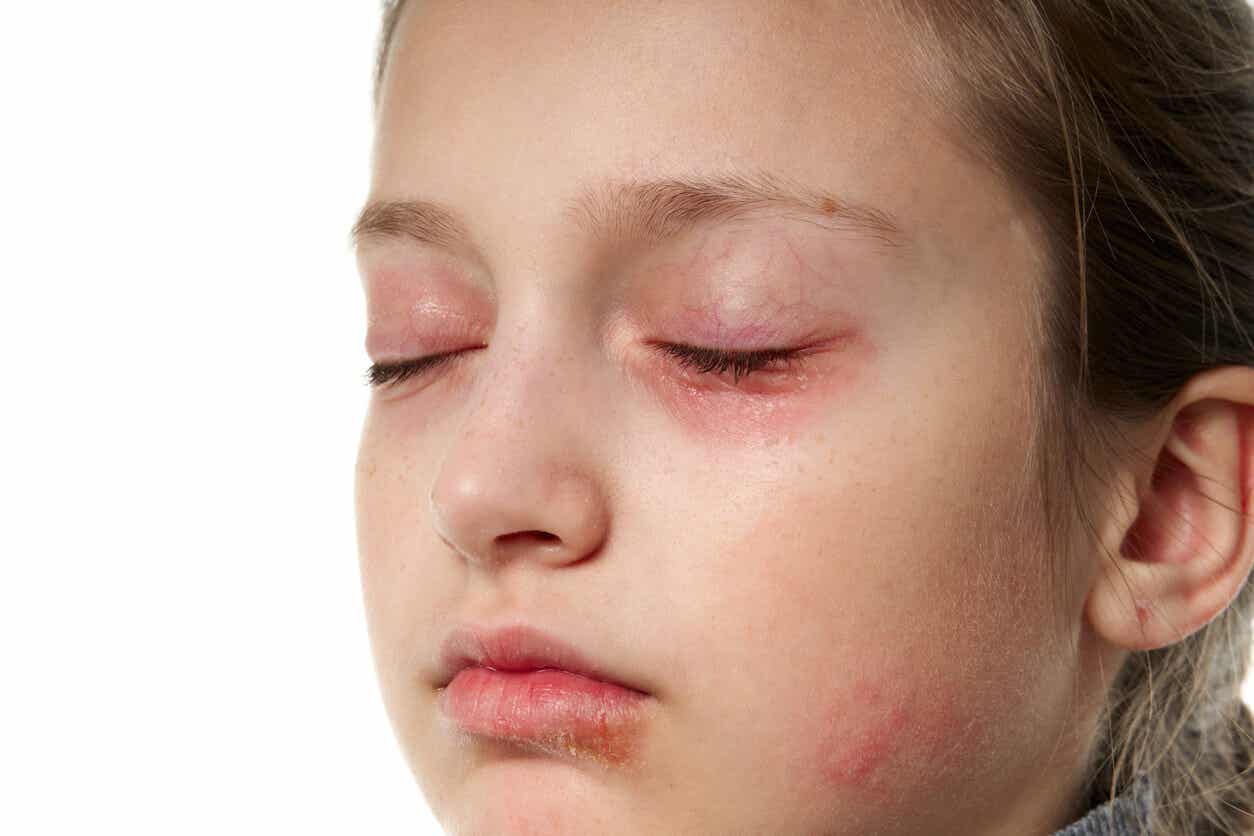What Do Dark Circles Under a Child's Eyes Mean?

Dark circles under a child’s eyes are a common clinical sign, characterized by a darkening of the skin under the lower eyelid. Its technical name is periocular hyperpigmentation, although there are other names for the same condition.
Although dark circles under a child’s eyes aren’t in themselves a health problem, they often indicate that some illness or issue is occurring in the child’s body. Do you want to know more about them? Then be sure to read what we’ll tell you below.
What are dark circles under a child’s eyes and what types are there?
Dark circles under the eyes are dark spots under the lower eyelids. They usually extend from side to side of the eyes, although sometimes they can completely surround them.
They occur for many reasons and aren’t always an indication of illness. Generally, these spots are more visible and striking in fair-skinned people.
This is because, at the level of the eyelids, the skin tissue is much thinner than on the rest of the face. Through this thin skin, you can see the vessels and other structures located in the deeper layers.
In paler skin, the contrast stands out more. However, dark circles under the eyes haven’t been shown to occur more frequently than in darker skin.
There are several types of periocular hyperpigmentation defined according to coloration and cause. These are as follows:
- Pigmented (dark brown in color)
- Vascular (the color varies between reddish, purple, or bluish)
- Structural (similar in color to the child’s skin)
- Mixed (resulting from a combination of two or three of the above types)
Read more: Everything You Need to Know About Moles in Children
What do dark circles under a child’s eyes say about their health?

A child with dark circles under their eyes looks as if they’re tired, even though they may not be. Their eyes appear more irritated, while the skin around the eyelids is drier and more cracked than usual.
It’s important to know that dark circles under the eyes aren’t an indication of a health problem per se. Even so, it’s important to know what causes them because many times, they can be the sign of a disease.
Through a correct physical examination of the child and a complete questioning, we can approach the diagnosis of the illness or hereditary factor that causes this sign.
The following are the most frequent causes of dark circles under the eyes in children.
The shadow of the tear duct
Before we begin to inquire about the causes of dark circles under the eyes, it is important to evaluate the patient in appropriate lighting conditions.
In some people, the tear duct slightly elevates the skin under the eyelid. If light hits the child’s face in a particular way, it can cause a shadow under the eye that simulates dark circles. For this reason, it’s essential to adjust the light when examining the child.
Hereditary causes
Numerous cases have been reported of families with this facial feature in several of their members, regardless of their age or health condition. This suggests that there’s a strong genetic influence on the development of dark circles under the eyes (Goodman-Belcher, 1969).
Most of the time, dark circles under the eyes are of early onset, even from early childhood. With the passage of time and accumulated damage from environmental factors (such as UV rays or stress), hyperpigmentation intensifies.
Lack of sleep
Tiredness and lack of sleep aren’t very frequent causes of dark circles under the eyes in children, although they can occur.
When children don’t get adequate rest at night, premature aging of the skin occurs. Therefore, the skin of their eyelids will tend to become thinner and more fragile than usual.
At the same time, lack of sleep favors the accumulation of fluid around the eyes. This is known as edema and usually takes on a bluish color.
Poor circulation
Some circulatory diseases, such as telangiectasias, or even inflammatory processes of the skin produce dark circles of a vascular type.
These dark circles are usually purplish or reddish in color, as they reflect the color of the small arteries that carry blood to the eyes. As inflammation causes arteriolar dilation, the color of the dark circles under the eyes will be bright red.
One way to diagnose dark circles under the eyes is to gently press the skin under the eyelids from the nose outward. As the finger moves sideways, the reddish color of the dark circles under the eyes disappears and is replaced by a deep violet color. After the pressure is removed, the dark circles will return to their original appearance.
Nasal congestion
Nasal congestion due to colds or respiratory allergies also causes vascular dark circles under the eyes. In addition, the child may have difficulty getting a good night’s rest, adding another factor to perpetuate periocular hyperpigmentation.

Trauma or rubbing
Casual blows or traumas can cause inflammation to outright injury of the tissues in the area. This results in increased blood congestion and, therefore, in the formation of hematomas or edema. These factors give a purplish appearance to dark circles under the eyes.
When the aggressions are slight but sustained over time, damage to the skin occurs similar to those that favor aging. Thus, dark circles under the eyes are structural or pigmented.
How to prevent dark circles under a child’s eyes?
Besides the causes that produce them, dark circles under the eyes are a purely aesthetic problem. For this reason, it’s important to evaluate with a specialist in children’s dermatology the most appropriate treatment option for each case.
As home remedies, cold compresses can be applied to the eyelids to help reduce swelling in the area. If the dark circles under the eyes are due to an allergic condition, such as eczema or atopic rhinitis, the use of antihistamine medication may help. In any case, this treatment will require a pediatrician’s prescription or recommendation.
To prevent dark circles under the eyes, it’s important to treat the underlying cause whenever possible and to take care of general skincare. This includes the following:
- Maintain an adequate state of hydration.
- Ensure a good night’s rest according to the child’s age.
- Use sunscreen every day of the year to prevent skin aging.
- Perform relaxing activities on a daily basis, as a way to educate stress management from an early age.
Conclusion regarding dark circles under a child’s eyes
Dark circles under the eyes aren’t a health problem, but they can alert us about some conditions that deserve our attention. It’s important to consult a doctor when they appear suddenly in order to make a good clinical assessment and evaluate the most appropriate treatment option.
Dark circles under a child’s eyes are a common clinical sign, characterized by a darkening of the skin under the lower eyelid. Its technical name is periocular hyperpigmentation, although there are other names for the same condition.
Although dark circles under a child’s eyes aren’t in themselves a health problem, they often indicate that some illness or issue is occurring in the child’s body. Do you want to know more about them? Then be sure to read what we’ll tell you below.
What are dark circles under a child’s eyes and what types are there?
Dark circles under the eyes are dark spots under the lower eyelids. They usually extend from side to side of the eyes, although sometimes they can completely surround them.
They occur for many reasons and aren’t always an indication of illness. Generally, these spots are more visible and striking in fair-skinned people.
This is because, at the level of the eyelids, the skin tissue is much thinner than on the rest of the face. Through this thin skin, you can see the vessels and other structures located in the deeper layers.
In paler skin, the contrast stands out more. However, dark circles under the eyes haven’t been shown to occur more frequently than in darker skin.
There are several types of periocular hyperpigmentation defined according to coloration and cause. These are as follows:
- Pigmented (dark brown in color)
- Vascular (the color varies between reddish, purple, or bluish)
- Structural (similar in color to the child’s skin)
- Mixed (resulting from a combination of two or three of the above types)
Read more: Everything You Need to Know About Moles in Children
What do dark circles under a child’s eyes say about their health?

A child with dark circles under their eyes looks as if they’re tired, even though they may not be. Their eyes appear more irritated, while the skin around the eyelids is drier and more cracked than usual.
It’s important to know that dark circles under the eyes aren’t an indication of a health problem per se. Even so, it’s important to know what causes them because many times, they can be the sign of a disease.
Through a correct physical examination of the child and a complete questioning, we can approach the diagnosis of the illness or hereditary factor that causes this sign.
The following are the most frequent causes of dark circles under the eyes in children.
The shadow of the tear duct
Before we begin to inquire about the causes of dark circles under the eyes, it is important to evaluate the patient in appropriate lighting conditions.
In some people, the tear duct slightly elevates the skin under the eyelid. If light hits the child’s face in a particular way, it can cause a shadow under the eye that simulates dark circles. For this reason, it’s essential to adjust the light when examining the child.
Hereditary causes
Numerous cases have been reported of families with this facial feature in several of their members, regardless of their age or health condition. This suggests that there’s a strong genetic influence on the development of dark circles under the eyes (Goodman-Belcher, 1969).
Most of the time, dark circles under the eyes are of early onset, even from early childhood. With the passage of time and accumulated damage from environmental factors (such as UV rays or stress), hyperpigmentation intensifies.
Lack of sleep
Tiredness and lack of sleep aren’t very frequent causes of dark circles under the eyes in children, although they can occur.
When children don’t get adequate rest at night, premature aging of the skin occurs. Therefore, the skin of their eyelids will tend to become thinner and more fragile than usual.
At the same time, lack of sleep favors the accumulation of fluid around the eyes. This is known as edema and usually takes on a bluish color.
Poor circulation
Some circulatory diseases, such as telangiectasias, or even inflammatory processes of the skin produce dark circles of a vascular type.
These dark circles are usually purplish or reddish in color, as they reflect the color of the small arteries that carry blood to the eyes. As inflammation causes arteriolar dilation, the color of the dark circles under the eyes will be bright red.
One way to diagnose dark circles under the eyes is to gently press the skin under the eyelids from the nose outward. As the finger moves sideways, the reddish color of the dark circles under the eyes disappears and is replaced by a deep violet color. After the pressure is removed, the dark circles will return to their original appearance.
Nasal congestion
Nasal congestion due to colds or respiratory allergies also causes vascular dark circles under the eyes. In addition, the child may have difficulty getting a good night’s rest, adding another factor to perpetuate periocular hyperpigmentation.

Trauma or rubbing
Casual blows or traumas can cause inflammation to outright injury of the tissues in the area. This results in increased blood congestion and, therefore, in the formation of hematomas or edema. These factors give a purplish appearance to dark circles under the eyes.
When the aggressions are slight but sustained over time, damage to the skin occurs similar to those that favor aging. Thus, dark circles under the eyes are structural or pigmented.
How to prevent dark circles under a child’s eyes?
Besides the causes that produce them, dark circles under the eyes are a purely aesthetic problem. For this reason, it’s important to evaluate with a specialist in children’s dermatology the most appropriate treatment option for each case.
As home remedies, cold compresses can be applied to the eyelids to help reduce swelling in the area. If the dark circles under the eyes are due to an allergic condition, such as eczema or atopic rhinitis, the use of antihistamine medication may help. In any case, this treatment will require a pediatrician’s prescription or recommendation.
To prevent dark circles under the eyes, it’s important to treat the underlying cause whenever possible and to take care of general skincare. This includes the following:
- Maintain an adequate state of hydration.
- Ensure a good night’s rest according to the child’s age.
- Use sunscreen every day of the year to prevent skin aging.
- Perform relaxing activities on a daily basis, as a way to educate stress management from an early age.
Conclusion regarding dark circles under a child’s eyes
Dark circles under the eyes aren’t a health problem, but they can alert us about some conditions that deserve our attention. It’s important to consult a doctor when they appear suddenly in order to make a good clinical assessment and evaluate the most appropriate treatment option.
All cited sources were thoroughly reviewed by our team to ensure their quality, reliability, currency, and validity. The bibliography of this article was considered reliable and of academic or scientific accuracy.
- Sakar R, Rajnan R, Garg S et al. Periorbital Hyperpigmentation: A Comprehensive Review. J Clin Aesthet Dermatol. 2016;9(1):49–55. Disponible en: https://www.ncbi.nlm.nih.gov/pmc/articles/PMC4756872/ [Acceso julio 2021].
- Vrcek I, Ozgur O, Nakra T. Infraorbital Dark Circles: A Review of the Pathogenesis, Evaluation and Treatment. J Cutan Aesthet Surg. 2016 Apr-Jun;9(2):65-72. doi: 10.4103/0974-2077.184046. PMID: 27398005; PMCID: PMC4924417. Disponible en: https://pubmed.ncbi.nlm.nih.gov/27398005/ [Acceso agosto 2021].
- Mayo clinic staff. Dark circles under eyes. [Internet] Año 2018. Disponible en: https://www.mayoclinic.org/symptoms/dark-circles-under-eyes/basics/definition/sym-20050624 [Acceso julio 2021].
This text is provided for informational purposes only and does not replace consultation with a professional. If in doubt, consult your specialist.








